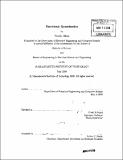Functional quantization
Author(s)
Misra, Vinith
DownloadFull printable version (8.053Mb)
Other Contributors
Massachusetts Institute of Technology. Dept. of Electrical Engineering and Computer Science.
Advisor
Vivek K. Goyal.
Terms of use
Metadata
Show full item recordAbstract
Data is rarely obtained for its own sake; oftentimes, it is a function of the data that we care about. Traditional data compression and quantization techniques, designed to recreate or approximate the data itself, gloss over this point. Are performance gains possible if source coding accounts for the user's function? How about when the encoders cannot themselves compute the function? We introduce the notion of functional quantization and use the tools of high-resolution analysis to get to the bottom of this question. Specifically, we consider real-valued raw data Xn/1 and scalar quantization of each component Xi of this data. First, under the constraints of fixed-rate quantization and variable-rate quantization, we obtain asymptotically optimal quantizer point densities and bit allocations. Introducing the notions of functional typicality and functional entropy, we then obtain asymptotically optimal block quantization schemes for each component. Next, we address the issue of non-monotonic functions by developing a model for high-resolution non-regular quantization. When these results are applied to several examples we observe striking improvements in performance.Finally, we answer three questions by means of the functional quantization framework: (1) Is there any benefit to allowing encoders to communicate with one another? (2) If transform coding is to be performed, how does a functional distortion measure influence the optimal transform? (3) What is the rate loss associated with a suboptimal quantizer design? In the process, we demonstrate how functional quantization can be a useful and intuitive alternative to more general information-theoretic techniques.
Description
Thesis (M. Eng.)--Massachusetts Institute of Technology, Dept. of Electrical Engineering and Computer Science, 2008. Includes bibliographical references (p. 119-121).
Date issued
2008Department
Massachusetts Institute of Technology. Department of Electrical Engineering and Computer SciencePublisher
Massachusetts Institute of Technology
Keywords
Electrical Engineering and Computer Science.